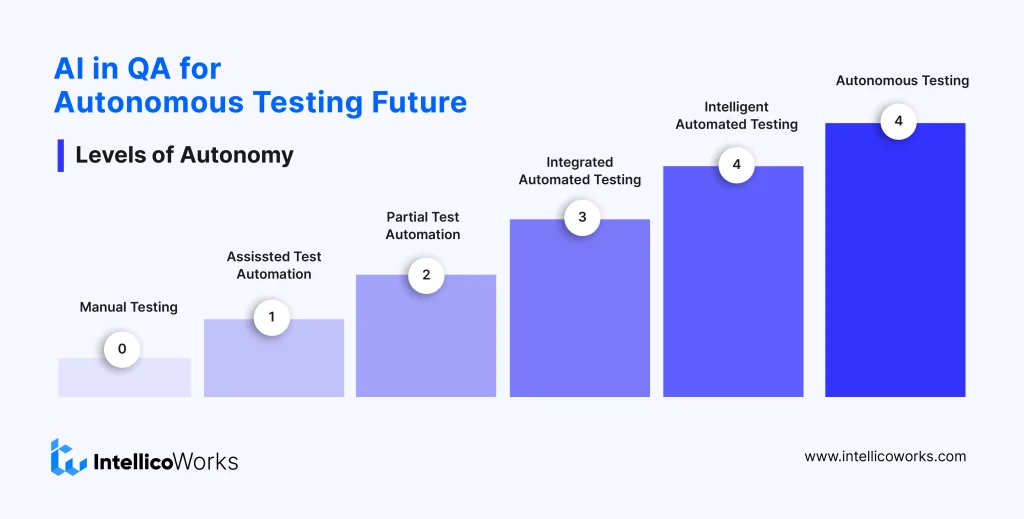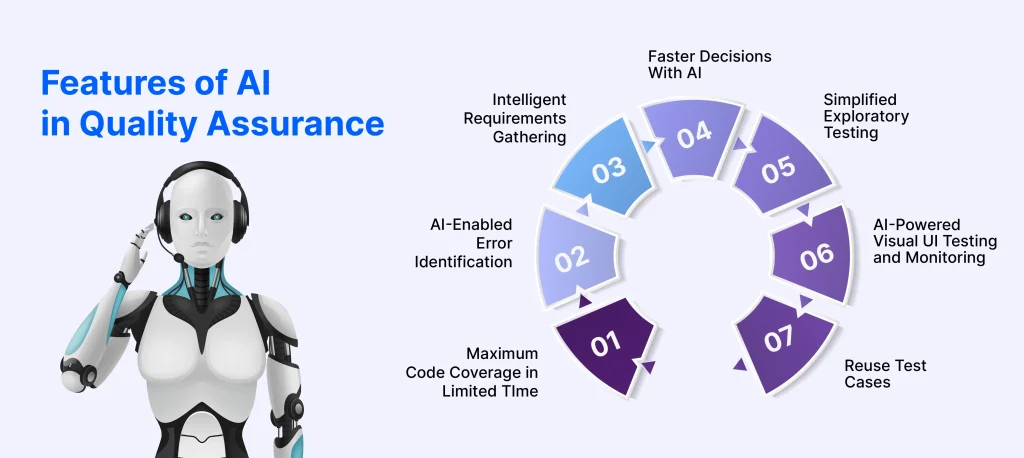When teams operate independently, it creates communication gaps that can lead to disorder. In contrast, when teams collaborate, they tend to be more efficient.
Software development processes have changed with the introduction of agile approaches. In the early days, mobile apps and software were released monthly or bi-monthly. With the rise in agile implementation, developers can release apps every week or even daily. These frequent releases needed quality assurance. Continuous testing came into the game to keep up with these frequent developments, and automation suits were built for sanity and regression testing. To streamline these processes, companies are adopting AI frequently. According to PwC, 70% of companies will have adopted at least one form of AI technology by 2030. AI in quality assurance provides the latest testing approach technique which advocates faster deliveries and accelerated testing cycles. It allows multiple deliveries of software per day. The report from PRNewswire anticipates, around 74% of professionals believe AI will significantly impact the QA and testing field.
With this technological advancement and the adoption of AI, every company needs to move towards digital transformation and automation to thrive in the market. Outdated test automation processes prevent QA testers from staying updated with agile development techniques. That is why traditional QA operations within enterprises must adapt to test agility. In this article, we will see how AI in quality assurance can bring major improvements, how to use AI for software testing, its benefits, and technologies to help clarify why it is essential for all other organizations, including yours.
Previously, testing in organizations was done manually. It took over 35% of the testing cycle time. This method was slow and prone to mistakes, leading to high costs and wasted resources. As software development becomes more complex, it gets harder to maintain a test suite. By incorporating AI in QA, organizations can overcome the limitations of manual testing. The shift from traditional Test Automation to Autonomous Software Testing (AUST) is driven by AI technologies like ChatGPT. This transition results in tests that are created, managed, and executed by AI, significantly reducing the need for human intervention and improving overall testing efficiency and accuracy. AI can also do advanced tasks that needed human intelligence before, such as:
AI can automate testing by supervising API testing, automating tasks, finding the best times to run scripts, and using spidering tools for data analysis. If you see the below graph, the position of the manual process of testing is at the lowest in terms of autonomy because it is 100% driven by humans. But, the autonomous testing model is the most ranked which slowly offloaded the repetitive tasks, freeing up the bandwidth of testers so that they can focus on more strategic tasks and high-level planning. Autonomous Testing is the final stage, where computers have full control over the testing process. Let’s see these stages level by level:

At level zero, code writing is a repetitive process. It includes adding fields to a page requiring a test. Adding any form to a page means adding a test that checks all fields. Adding a page involves reviewing all components and forms through a new test. More tests lead to greater instances of failing to ensure app functionality. To solve this, check all failed tests to identify bugs or fresh baselines.
At this level, the AI application enhances the autonomy of Quality Assurance (QA) by analyzing the page’s Document Object Model and visual picture holistically. This approach helps write checks that would otherwise be manually written. AI technology can assist in test code writing, check test passes, and notify users of failures, allowing for verification of real failures or software changes. Overall, AI technology enhances the efficiency of QA processes.
At Level 1, the AI can be used to automate the tedious task of writing checks and testing the visual elements of a page. It can also group changes from multiple pages using semantic understanding, which app users can understand. At Level 2, the AI can determine if the changes made are the same and ask whether to accept or reject them as a group.
At Level 3, AI can evaluate app changes or failures without human intervention. By applying machine learning techniques, AI can examine visual elements and determine if the UI is off based on standard design rules. This level of AI can evaluate pages without human intervention, analyzing data and designing rules over time. It can identify differences in changes using machine learning, allowing for more efficient and accurate app evaluation.
Level 4 AI is set to replace humans in driving tests, as it can examine apps and software semantically and understand them like humans would. This AI can see user interactions over time, visualize interactions, and understand page and user flow. Once it understands the page type, it will use reinforcement learning techniques to automatically drive tests.
At this stage, AI will communicate with the product manager, understand the app, and drive the tests automatically. AI is currently in Level 1, but it can communicate with product managers, understand apps, and drive tests independently. AI is already used in automation events like visual UI testing, API testing, automated quality assurance, and spidering, despite being still in its early stages.
Integrating AI into QA and testing processes offers numerous benefits that collectively enhance the efficiency, accuracy, and overall quality of software testing. AI in automation testing ensures robust and reliable applications. Leveraging AI in software test automation transforms traditional QA practices into a more dynamic, accurate, and efficient process. Here are some of the practical benefits and features of AI in test automation:

AI speeds up decision-making in QA testing. It quickly analyzes data and provides actionable insights. This boosts efficiency and reduces decision-making time. As a result, automated quality analysis becomes more effective.
AI simplifies exploratory testing by automating the generation of test cases and scenarios. AI exploratory testing allows testers to focus on more complex and creative testing activities. As a result, it enhances the depth and breadth of test coverage and improves AI quality assurance.
AI models perform testing of user interfaces (UI) by identifying discrepancies in UI elements such as color, shape, and size. Implementing AI can significantly reduce the need for manual visual inspections and ensure consistent UI quality across different devices and platforms, a critical aspect of AI QA testing.
AI facilitates the reuse of test cases by identifying patterns and similarities in test scenarios. This capability reduces the effort required to create new test cases and ensures comprehensive test coverage, enhancing automated quality analysis.
AI-driven tools can achieve maximum code coverage in a limited time by efficiently scanning and testing large volumes of code. This ensures that all possible code paths are tested, reducing the risk of undetected bugs and improving AI quality assurance.
AI models quickly identify errors in code by analyzing log files and detecting anomalies. This reduces the time and effort required to locate and fix bugs, leading to higher software quality and more reliable AI QA testing.
AI assists in gathering and understanding requirements by analyzing user stories, documentation, and previous project data. This ensures that all requirements are captured accurately, reducing the risk of missing or misunderstood requirements, a crucial component of AI quality assurance.
AI can be used to train diffusion models that predict the spread of changes in code and their impact on the software. This predictive capability helps in identifying potential issues early in the development process, allowing for proactive resolution in AI QA testing.
An increase in the use of AI-driven quality assurance platforms gradually gaining prevalence in the industry. The tools help address quality assurance processes, providing efficiency and accuracy in testing procedures. Here are some of the top AI test automation tools:
AI automation platforms are transforming the way we approach machine learning, data processing, and user interaction. There are many platforms to use, and each platform brings unique capabilities to the table, enabling developers and businesses to leverage AI technology in innovative and effective ways. Let’s see some of them:
TensorFlow is an open-source software library. It offers tools, libraries, and community resources that allow developers to deploy computation to one or more CPUs/GPUs in a desktop, mobile device, or server using a single API. The flexibility of this tool facilitates all stages of machine learning, from model building to deployment.
Google AI Platform is an aid for the creation of application-specific models and the enhancement of existing model architectures through an automated AI software development service. This platform supports developers throughout the entire process. It also enables them to build and run their machine-learning applications
Microsoft Azure is a public cloud computing platform. It has different cloud services like computing, analytics, storage, and networking. It is particularly known for its flexibility, advanced site recovery, and built-in integration. This makes it a highly effective tool for backup and disaster recovery.
Dialogflow excels in natural language understanding. It is capable of simplifying the process of designing and integrating a conversational UI into various applications, such as mobile and web applications, AI bots, devices, interactive voice response systems, and more.
MindMeld is a conversational AI platform. It is designed for building conversational assistants. These assistants demonstrate a deep understanding of a specific use case or domain. They provide highly valuable and adaptable conversational experiences.
Incorporating AI into your quality assurance strategy is not just a future trend; it’s a strategic decision that can provide your enterprise with a significant competitive advantage. The global AI market itself reflects this growing importance. According to Grand View Research, the market was valued at U.S. $93.5 billion back in 2021 and is expected to experience a compound annual growth rate (CAGR) of 38.1% from 2022 to 2030. This surge can be attributed to the continuous research and innovation in AI, driven by tech giants who are integrating these advanced technologies across various industries like automotive, healthcare, retail, finance, manufacturing, IT and quality assurance. Intellicoworks is an AI development company. Being at the forefront of AI development services, they offer cutting-edge solutions to streamline your testing processes, improve efficiency, and ensure the highest quality for your software. Our team of experts can help you leverage AI to automate tasks, identify bugs early in development, and deliver exceptional user experiences.
In summary, AI in quality assurance implementation is rapidly evolving. Businesses that prioritize quality and efficiency are embracing AI-powered testing solutions at the forefront. As shown by the statistics, a significant portion of organizations (44%) are already leveraging AI in their testing processes. These organizations are already reaping the benefits of faster development cycles and improved software quality. These advancements are not merely theoretical; a substantial 37% of businesses have experienced tangible improvements in launch times and overall performance through AI-powered testing and QA to a report. Embrace AI and unlock the door to a future of exceptional software quality and expedited delivery.
Discover Cutting-Edge AI Solutions for Software Development!

Talk to us and let’s build something great together
A Subsidiary of Vaival Technologies, LLC
IntelliCoworks is a leading DevOps, SecOps and DataOps service provider and specializes in delivering tailored solutions using the latest technologies to serve various industries. Our DevOps engineers help companies with the endless process of securing both data and operations.
Ops
Cloud
AI & ML
Copyrights © 2023 byIntellicoworks. All rights reserved.